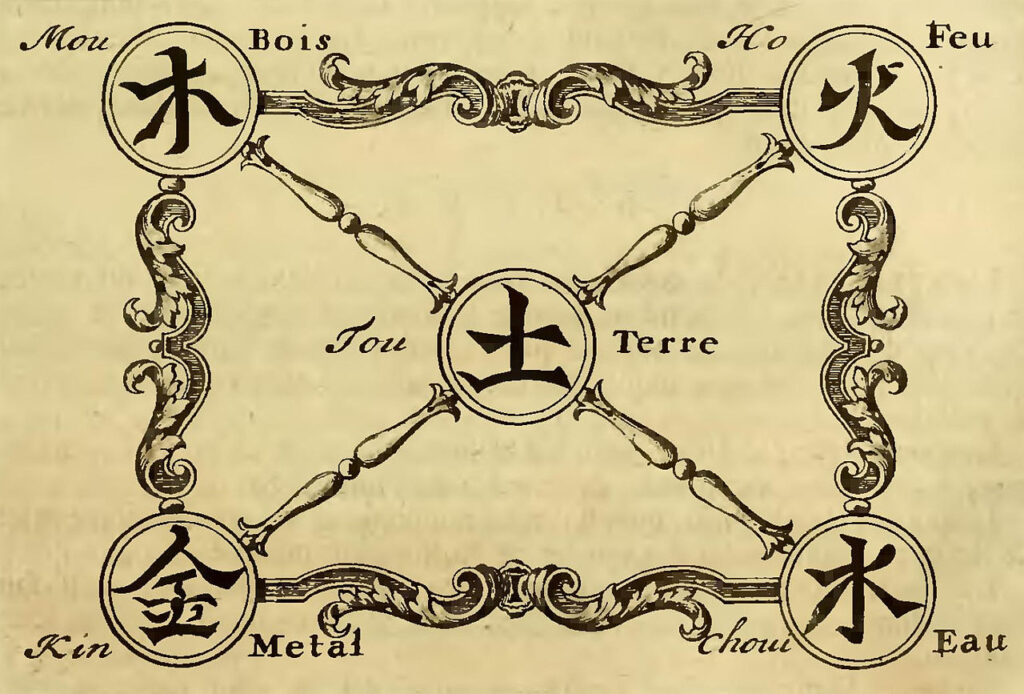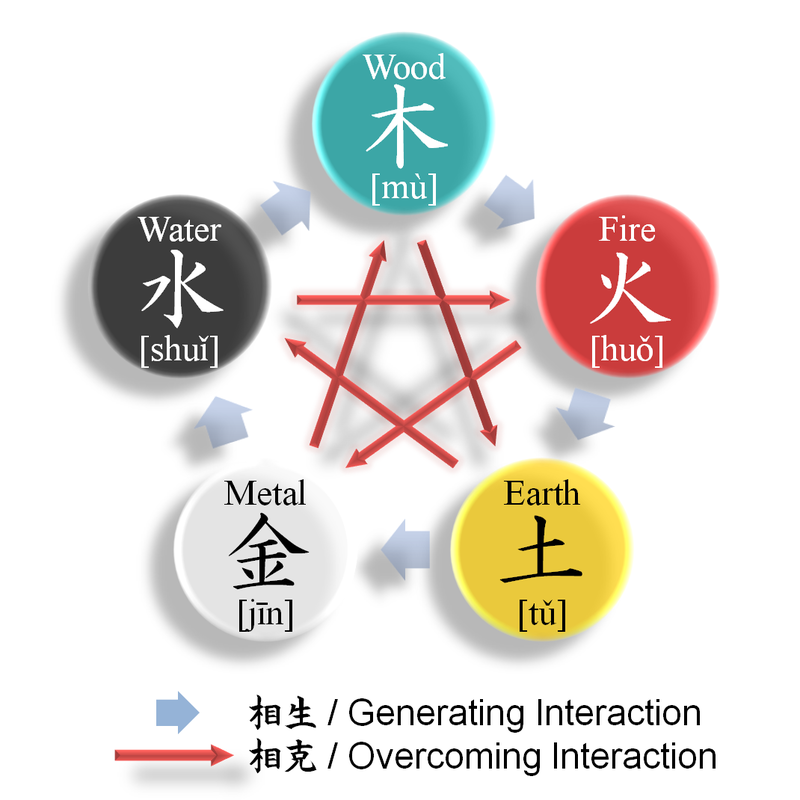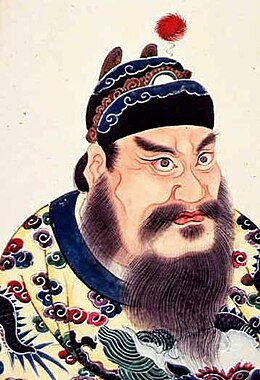
After the emergence of the words yang and yin as geographical terms used to specify a location, yang first, in connection with the sun, for the south side of a mountain, and yin later on to refer to its north side, the two words appeared as linked in the Shijing (The Book of Odes), one of the Five Classics, in the sentence “Viewing the scenery at hill, looking for yinyang.” The interplay of yinyang was originally used to regulate the lives of farming communities by providing a calendar as well as general guidance in how to lead one’s life. It, however, in time developed into an instrument for divination before becoming a conceptual tool to explicate natural phenomena, and thereby led to the elaboration of a mode of thinking based on the paradoxical interaction between yin and yang in a cosmos conceived as a dynamic interconnected whole. This mode of thinking, based on contradiction, interdependence, mutual inclusion, complementarity, and the affirmation of change, is radically different from the western ontological mode of thinking, which is based on a definition of “what really is” “being” (“on”) as what is permanent with a reliance on abstract concepts rather than on concrete experience. See previous page in the Yinyang section for details.
It is with the Jixia Academy (founded in 318 BCE) and Zou Yan (305-240 BCE), regarded as the founder of the Yinyang School (also called the School of Naturalists), that the yinyang concept emerged officially in the landscape of Chinese philosophy. Wang writes: “Several important texts associated with this academy make significant contributions to yinyang thought. The Guanzi (the Master Guan), an encyclopedic compilation of philosophical materials named after Prime Minister Guan Zhong in the 7th century, is particularly significant in giving a detailed account how yinyang and wuxing (five elements, phases, processes) were linked together …. We begin to see the central aspects of yinyang described: the complex relationship between opposite forces, the emphasis on generation and growth, and the use of yinyang as a strategy for living well.”
Though already part of the lives of ordinary people, as concepts, the words yin and yang are not mentioned in Confucian texts such as the Analects, Mengzi, the Great Learning or Zhongyong, and the word only appears in Chapter 42 in the Daodejing (though, of course, the whole Daodejing is an explicitation of yinyang!). Wang explains that “The schools we have come to call Confucianism and Daoism, however, were only a small part of the wide range of positions and views in what later became known as the period of ‘a hundred schools.” It is often said that Daoism developed as a rebellion against Confucianism. This is how Daoism is described in the Zhuangzi. Wang only says that yinyang, along with other aspects of Daoism, arose as from ordinary people as what we would call a grassroots movement, as all indigenous spiritualities do, whereas Confucianism came top-down from the elites in power as soon as a government imposes its will in the context of an empire. The Daodejing presents guidelines for another way to govern, other ways of dealing with socio-political issues. The Warring States Period (480-221 BCE) was a time of internecine warfare raging with escalating ferocity as one hundred small states turned into seven major states which, with a combination of alliances and wars, ended when the Qin gained the overall control of what has become China. The suffering ordinary people went through during these two and a half centuries fueled an intense quest for a way out of this uninterrupted violence, just as the Kamakura period was later to lead to the birth of new religious thought in Japan.
Wang writes that, unfortunately, “the works of the Yinyang School have been ‘largely lost’.” We do know, however, that, “in the Shiji (Records of the Historians), Sima Tan, the early Han period (206 BCE-8 CE) historiographer, listed the Yinyang School as the first of six Chinese intellectual schools.”
In addition, one can find in the Hanshu details about the origins of each of the early schools of Chinese thought, which it traces to “different kinds of shi, the class of intellectuals and specialists who were government officials and advisors.” Specifically, concerning the Yinyang School, Wang continues: “The Yinyang School [came] from fangshi (specialists in techniques) who engaged in a wide array of practical skills, from reading the oracle bones and observing seasonal transformations, to analyzing political events and cycles of histories, to devising military strategies. A C Graham calls these fangshi “men of secret arts … The course of the Yinyang School probably came from officials for astrology, reverently following great heaven, the calendar, moon, sun, and stars .… They reverently gave out the proper timing [shi, seasons] for the people and this is what they were strong in. When it comes to enacting restraints then they were bound by prohibitions and taboos and sunken in minor numerology, abandoning human affairs to rely on ghosts and spirits.”
Wang adds: “The same chapter [in the Honshu] explains further the basis of these practices: Yinyang is following the time to issue out; going forward by xingde, in accordance with the stars [douji] and five elements, relying on the five conquering and using the assistance of the ghosts and spirits.”
Xingde – The Five Elements or Processes

This passage of the Honshu raises 3 technical terms associated with particular methods, or shu, involved with astrology and numerology.
Wang writes: “The first is xingde, which is a method associated with the five elements: water, wood, metal, earth, and fire … “Xing” refers to yin-conquering (yinde), and “de” refers to yang-generating (yangsheng). The second technical term is wusheng, “fire-conquering,” which also concerns the mutual relationships among the five elements. Water will conquer fire, fire conquers metal, metal conquers wood, wood conquers earth, and earth conquers water. The third specific technique mentions is douji, which was a form of divination based on the position of the Big Dipper, which could be used to predict the outcome of battles, depending on which direction it pointed.”
The integration of yinyang with the five phases (wuxing) theory is regarded as the most significant contribution Zou Yan made to the yinyang theory. Before the Han Dynasty, the terms yinyang and wuxing had developed out of different contexts. To be precise, Wang explains, “Yinyang originally focused more on the rhythm of time, whereas the wuxing was more attuned to the position and direction of terrain. Zou Yan may have been the first person to link them. He took resonance as an operative principle between yinyang and wuxing and, thus, integrated the yinyang theory into a broader conceptual ground. Yinyang is the nature or potency (xing) of the five phases, and the five phases are the properties (zhi) of yinyang. This marriage of yinyang and wuxing enriched and complicated the yinyang theory.”
Chapter 42 of the Daodejing, as translated by Red Pine, described the process of manifestation of the many out of the one Dao:
The Dao gives birth to one
one gives birth to two
two gives birth to three
three gives birth to ten thousand things
ten thousand things with yin at their backs
and yang in their embrace
and breath between for harmony
Shall I venture to say that the Dao, as one dynamic principle, manifests through the interaction of yinyang, which gives birth to the qi, which in turn give birth to the ten thousand things – that is the forms of the phenomena we encounter in our everyday lives – through the multifaceted sets of correlations and interactions between the five “elements” – or, better, processes.

Other translations used by scholars are “five phases,” and “five processes. Five elements came about through a comparision between the Chinese series and the corresponding series in Greek and Indian philosophies, which, however, only listed four elements. But of course, whereas the latter were seen primarily as substances, the Chinese xing are dynamic forces. A C Graham says that “right down to the syncretistic Huainanzi (c. 140 BCE) the Five Hsing (xin) appear to be, not the materials, nor phases in cycles, but processes such as fire rising and burning, water wetting and sinking.” But it seems that the Chinese themselves are still using the word “elements” for the same reason Neidan practitioners are still using words such as “elizir,” as they transpose words used in external alchemy into internal alchemy: for them all “things” are both substance and energy, so switching to energy drops the substantial aspect, and you are still stuck with a one-sided view!
Wang tells us that “There are two hypotheses about the origins of wuxing theory. One holds that the concept of wuxing resulted from the idea of the five directions: east, west, south, north, and center. Others contend that the five phases arise from accounting for seasonal changes. The term wuxing (five phases) first appeared in the Hong fan (“Great Plan”) chapter of the Book of History (Shangshu). It refers to five material things with certain functional attributes: “Water is said to soak and descend; the fire is said to blaze and ascends; wood is said to curve or be straight; metal is said to obey and change; earth is said to take seeds and give crops. These five phenomena are not static entities, but rather five phases that move according to their own internal natures. Although wuxing has sometimes been translated as “five elements,” they are not fixed kinds of stuff but rather different functions and moments of change. As Joseph Needham states, the five phases are “five forces in ever-flowing cyclical motion, and not passive motionless fundamental substances.”
She adds, however, that “The importance of wuxing lies not in the five forces themselves, but rather in how they relate. In the book Great Meaning of Wuxing (Wuxing Dayi), Xiao, a scholar from the Sui Dynasty (581-618), clearly formulates the two interlocking sequences or cycles by which the phases alternate: xiangsheng (mutually generating) and xiangke (mutually conquering). The generating sequence is: water generates wood; wood generates fire; fire generates earth; earth generates metal; and metal generates water. The conquering sequence is: water conquers fire; fire conquers metal; metal conquers wood; wood conquers earth; wood conquers earth; and earth conquers water. These are two standard functions of the five phases.”
Yuasa Yasuo has described this mode of thinking as “image-thinking.” Ancient Greece, India and China inherited this way of thinking from early pre-literate peoples who saw nature as filled with life, with no separation between spirit and matter. What is now referred to as “panpsychism” is a view that grasps the natural world through concrete images conducive to an attunement with its many phenomena. It is an intuitive grasp of the whole, led by the image, rooted in a feeling.” In fact, in Greece, one still find evidence of “image-thinking” in the Milesian school as it saw the natural world as arising from the activity of four archai, corresponding to the four elements – earth, water, fire, and air. But, Yuasa insists, “what Thales called “water” was not [just] the water we see in our everyday life, but was a symbolic expression designating the invisible power that operates within nature.” In contrast, the West’s metaphysical thinking based on Plato’s “Ideas,” and even more, the calculative thinking based on Descartes’s dichotomy of res cogitans (mind) and res extensa (matter), its modern corollary now prevalent in the West, involve an “analysis” of conceptual representations, breaking down into parts what one is trying to understand, followed by a “synthesis” rearranging these parts into a meaningful whole.
Yuasa argues that, as the Chinese language has retained the original images that had given rise to its concepts, there has been no need to develop a complex syntax linking the various sinographs of a sentence, it has retained an image-based mode of thinking which requires the reader or listener to move back and forth between the text and their experience. As a result there had been no flight into the abstract, decontextualised, terminology of science and technology that has swamped “modernity” and the crisis that is associated with it.
Back to wuxing, Wang explains that there had developed another dimension of wuxing thought “beyond mutual generation (xiangsheng) and mutual overcoming (xiangke), generating patterns of mutual controlling (xiangzhi). Mutual controlling refers to a complex pattern in which one phase generates a second phase that controls a third phase that itself controls the first phase. An example will clarify this: metal can conquer wood, however, wood can generate fire, which controls metal. From one perspective, wood is conquered by metal, however, metal can fight back by producing fire to control metal, using its generative function against the controller. The pattern of mutual transforming relies on the use of generation to resolve tensions. For example, metal can conquer wood, however, metal can also generate water, which then generates wood. Water conquers fire, however, water also generates wood. Water conquers fire, however, water also generates wood, which itself generates fire. These are indirect effects reflecting a concern with complexity and interrelatedness rather than a linear way of thinking.”
Wuxing is applied to all aspects of reality in conjunction with yinyang. For instance, in Chinese medicine, it correlates with a wide range of emotions. “Anger belongs to wood, happiness belongs to fire, worry to earth, sadness belongs to metal, and fear belongs to water. These set up certain relationships between the emotions. One can use sadness (metal) to conquer anger (wood), use anger (wood) to conquer worry (earth), use worry (earth) to conquer fear (water), use anxiety (water) to conquer happiness (fire), and use happiness (fire) to conquer sadness (metal). At the same time, these emotions are connected to the five organs: anger affects the liver, happiness affects the heart, worry affects the spleen, sadness affects the lungs, and anxiety affects the kidneys. With these connections, one attempts to alleviate health problems by transforming emotions. Worrying (earth) can generate fear (water), and the only way to control worrying is through anger (wood).”

Zou Yan applied it “to Confucian moral codes to explicate the change of dynasties. This is known as “Theory of the Beginning and Ending of Five Forces” (Wude Zhongshi Shuo). The theory holes that the historical changes in dynasties were the result of the generating and controlling functions of five phases, thus making a wide connection between the movement of natural forces and human events.” Each dynasty was identified with one natural force: Xia Dynasty with wood, Shang Dynasty with metal, Zhou Dynasty with fire, and Qin Dynasty with water. “Just as fire will naturally melt metal, the Zhou Dynasty, thus, had a natural and inevitable propensity to replace the Shang (Yin) Dynasty. However, it would itself be conquered by water, in just the way that fire will naturally melt metal but will itself be extinguished by water. This theory led Qin Shihuang (259-210 BCE), the first emperor of a unified China, to define the Qin Dynasty as water so that it would necessarily take over Zhou, based on fire. It also led to important debates in the Han Dynasty about whether it should be water (thus excluding the Qin as a legitimate dynasty) or should be eath (thus naturally overcoming the Qin).
Wang concludes the chapter: “The main point is that because each dynasty has its own natural propensity to conquer or replace the other dynasty or phase, these dynasties alternate in a natural process, just as metal triumph over wood, fire overcome metal, and water puts out fire. This gives a naturalistic justification for dynastic change, as opposed to more traditional models that explained the change of dynasties through the mandate or command of heaven based on the virtue of rulers.”
Sources:
Robin R. Wang – Yinyang: The Way of Heaven and Earth in Chinese Thought and Culture
A C Graham – Disputers of the Tao
Yuasa Yasuo – Overcoming Modernity – Synchronicity and Image-Thinking
